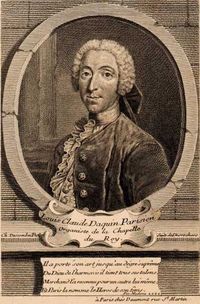
Louis-Claude Daquin
Encyclopedia

Composer
A composer is a person who creates music, either by musical notation or oral tradition, for interpretation and performance, or through direct manipulation of sonic material through electronic media...
of Jewish birth writing in the Baroque
Baroque music
Baroque music describes a style of Western Classical music approximately extending from 1600 to 1760. This era follows the Renaissance and was followed in turn by the Classical era...
and Galant
Galant
In music, Galant was a term referring to a style, principally occurring in the third quarter of the 18th century, which featured a return to classical simplicity after the complexity of the late Baroque era...
styles. He was a virtuoso organist
Organ (music)
The organ , is a keyboard instrument of one or more divisions, each played with its own keyboard operated either with the hands or with the feet. The organ is a relatively old musical instrument in the Western musical tradition, dating from the time of Ctesibius of Alexandria who is credited with...
and harpsichord
Harpsichord
A harpsichord is a musical instrument played by means of a keyboard. It produces sound by plucking a string when a key is pressed.In the narrow sense, "harpsichord" designates only the large wing-shaped instruments in which the strings are perpendicular to the keyboard...
ist.
Life
Louis-Claude Daquin was born in Paris, to a family originating from Italy (where their name was D'Aquino). One of his great-uncles was a professor of Hebrew at the Collège de FranceCollège de France
The Collège de France is a higher education and research establishment located in Paris, France, in the 5th arrondissement, or Latin Quarter, across the street from the historical campus of La Sorbonne at the intersection of Rue Saint-Jacques and Rue des Écoles...
. Daquin was a musical child prodigy. He performed for the court of King Louis XIV at the age of six. He was for a while a pupil of Louis Marchand
Louis Marchand
Louis Marchand was a French Baroque organist, harpsichordist, and composer. Born into an organist's family, Marchand was a child prodigy and quickly established himself as one of the best known French virtuosi of his time. He worked as organist of numerous churches and, for a few years, at the...
. At the age of 12, he became organist at the Sainte-Chapelle
Sainte-Chapelle
La Sainte-Chapelle is the only surviving building of the Capetian royal palace on the Île de la Cité in the heart of Paris, France. It was commissioned by King Louis IX of France to house his collection of Passion Relics, including the Crown of Thorns - one of the most important relics in medieval...
, and in the following year took a similar post at the church of the Petit St. Antoine.
Claude Daquin never lacked for work as an organist. In 1727 he was appointed organist at the church of St. Paul in Paris, ahead of Jean-Philippe Rameau
Jean-Philippe Rameau
Jean-Philippe Rameau was one of the most important French composers and music theorists of the Baroque era. He replaced Jean-Baptiste Lully as the dominant composer of French opera and is also considered the leading French composer for the harpsichord of his time, alongside François...
who was also a candidate. Five years later he succeeded his teacher Louis Marchand as organist at the Église des Cordeliers. In 1739 he became organist to the king. In 1755 he was made titular organist at the cathedral
Cathedral
A cathedral is a Christian church that contains the seat of a bishop...
of Notre-Dame de Paris, succeeding Antoine Calvière.
By reputation a dazzling performer at the keyboard, Daquin was courted by the aristocracy and his great expertise at the organ drew large crowds to hear him. He was known for his "unfaltering precision and evenness" at both the harpsichord and organ.
Compositions
At the age of eight, he conducted his own choral work Beatus Vir.Daquin's surviving music includes four harpsichord suites, a Nouveau livre de noëls for organ and harpsichord (settings of Christmas pastorals, which include some of his harpsichord improvisations), a cantata
Cantata
A cantata is a vocal composition with an instrumental accompaniment, typically in several movements, often involving a choir....
, and an air à boire
Air à boire
Air à boire is a French term which was used between the mid-17th and mid-18th centuries for a "drinking song". These were generally strophic, syllabic songs to light texts...
. Among the most famous of his works are the Swiss Noel (Noël Suisse, No. XII of his Nouveau livre), and Le coucou ("The Cuckoo
Cuckoo
The cuckoos are a family, Cuculidae, of near passerine birds. The order Cuculiformes, in addition to the cuckoos, also includes the turacos . Some zoologists and taxonomists have also included the unique Hoatzin in the Cuculiformes, but its taxonomy remains in dispute...
") which is from his 1735 harpsichord suite.
Among technical innovations, his Trois cadences for harpsichord contains a triple trill.
Media
External links
- Daquin
- Click one of these links to listen to 3 "Noëls" on the organ
- arranged for Accordion by Nikolai Ryskov

